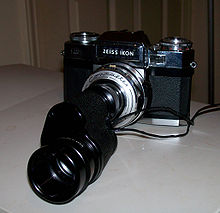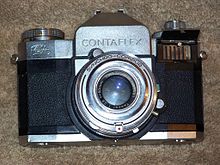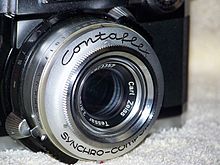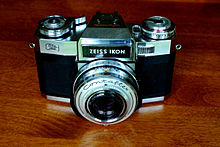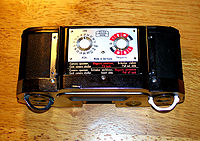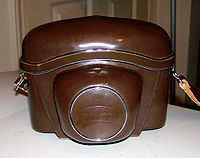- Contaflex SLR
-
Contaflex 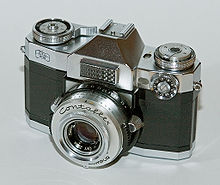
Type 35mm SLR camera Lens mount bayonet Focus manual Exposure manual Flash cold shoe The Contaflex series is a family of 35mm leaf-shuttered SLR cameras, produced by Zeiss Ikon in the 1950s and 1960s. The name was first used in 1935 on a 35mm Twin Lens Reflex camera, the Contaflex TLR also by ZI.
The Contaflex SLR was introduced in 1953 as one of the first 35mm SLR cameras equipped with a between-the-lens leaf shutter. The Mecaflex was presented at Photokina in 1951 and was launched two years later. This design, using a leaf shutter in an SLR, involves a complex sequence of events when the shutter button is release, more looked upon as a challenge than a drawback at Zeiss Ikon, but no Contaflex model ever got a rapid return mirror. The advantages are low manufacturing costs, compactness and flash synchronization at all shutter speeds. However, only a very limited range of interchangeable lenses are possible. The range was from 35mm to 115mm focal length; at the time regarded as quite sufficient, as most would only be used with the standard lens anyway.
Three years later, in 1956 the Kodak Retina Reflex was launched, followed by the Voigtländer Bessamatic and the Ultramatic. The market soon flourished with leaf-shuttered SLR cameras. However, the mechanical complexity required precision assembly and high quality materials. More often than not, the cameras lacked reliability, while the Contaflex, the Retina Reflex and the Bessamatic cameras performed well and sold in quantities.
Contents
Contaflex I and II
Contaflex
Early Contaflex II SLR CameraType 35mm SLR camera Focus manual Exposure manual The Contaflex I, launched in 1953, was equipped with a fixed Zeiss Tessar 45mm f:2.8 lens with front-cell focusing. The very first Contaflex I had a Synchro-Compur shutter with the old scale of shutter speeds (1-2-5-10-20-50-100-200-500), but very soon it adopted the new scale 1-2-4-8-15-30-60-125-250-500.
The Contaflex II, introduced the following year, was the same camera with an uncoupled selenium meter added to one side of the front plate.
Both had a fixed lens but to the front of which could be attached a supplementary lens, called the Teleskop 1.7x.
Contaflex III and IV
The Contaflex III, launched in 1956, was the same as the I, but equipped with a Zeiss Tessar 50mm f:2.8 with helical focusing. The front element of the lens was removable and could be replaced by supplementary lenses, discussed in the section Contaflex lenses.
The Contaflex IV, introduced the same year, was the same camera with the uncoupled meter inherited from the Contaflex II.
Contaflex Alpha and Beta
The Contaflex Alpha and Contaflex Beta, both introduced in 1957, were based on the same body but equipped with a Zeiss Pantar 45mm f:2.8 three-element lens and a Prontor Reflex shutter up to 1/300. They were the cheaper models of the line. The Alpha had no meter and the Beta had the selenium meter of the II and IV.
The front element of the lens could be interchanged with others for 30mm f:4 and 75mm f:4. These could also be used on the Contina III 35mm viewfinder camera.
Contaflex Rapid and Super
Contaflex Super Type 35mm SLR camera Focus manual Exposure manual The Contaflex Rapid was introduced in 1958 and had a slightly longer body, a built-in accessory shoe, a winding lever and a rewind crank. It was the meterless version.
The Contaflex Super, launched the following year, was based on the Rapid and had a coupled selenium exposure meter on the front side of the prism. It is easily recognized by the wheel on the front plate for the setting of the aperture. The meter needle was visible in the finder as well as on the top plate from the outside. It is not to be confused with the Super (new) that will be discussed later.
The Rapid and Super could take the same supplementary lenses as the III and IV.
Contaflex Prima
The Contaflex Prima, launched in 1959 and sold until 1965, was based on the body of the Rapid, but with the Pantar lenses and the Prontor shutter like the Alpha and Beta. The Prima had a coupled exposure meter placed on the side of the front plate, different from that of the Super.
The Prima could take the Pantar supplementary lenses like the Alpha and Beta.
Contaflex Super (new) and Super B
Contaflex Super B
Contaflex Super BType 35mm SLR camera Focus manual Exposure automatic/manual ]
The Contaflex Super (new) and Contaflex Super B are very similar cameras. Both have a new body design, both longer and more bulky. The information about which came first is a bit contradictory in some reference books, but it seems the Super (new) was launched in 1962, introducing the new body design and a new selenium exposure meter in a prominent rectangle marked Zeiss Ikon in front of the prism. The aperture wheel was replaced by a more traditional aperture command, and the meter read-out was visible both on the exterior and in the finder.
The Super B was launched in 1963, and added a shutter-priority automatic aperture, and maybe some other small changes.
The new body of the Super (new) and Super B allowed them to take magazine backs, interchangeable with a partly exposed film inside. (Magazine backs, rare among 35mm cameras, were also supplied for the Contarex of Zeiss Ikon.)
From the Super (new) and Super B, the Zeiss Tessar 50mm f:2.8 lens was recomputed and supposedly performed better. They could still take the same supplementary lenses, with one exception discussed in the relevant section.
Contaflex Super BC and S
The Contaflex Super BC was introduced in 1965, and was a Super B with the selenium meter replaced by a CdS through-the-lens exposure meter. It still had a black rectangle marked Zeiss Ikon on the front of the prism, but it was only decorative. It had a battery compartment at the bottom front.
The Contaflex S was the last variant, introduced in 1968, and was simply a renamed Super BC. It had a black rectangle marked Contaflex S on the front, and a different, newer Zeiss Ikon logo. It proudly sported the word Automatic on the front of the shutter.
The Super BC and S could take the magazine backs, as well as the usual supplementary lenses.
Both the Contaflex Super BC and S were sold in chrome or black; they were the only Contaflex models to be produced in black.
Contaflex lenses
We have already seen that the Contaflex I and II could only take the Teleskop 1.7x supplementary lenses, and that the Alpha, Beta and Prima had their own limited range of Pantar supplementary lenses.
The models III, IV, Rapid, Super, Super (new), Super B, Super BC and S all have a Zeiss Tessar 50mm f:2.8 lens (27mm screw-in or 28.5mm push-on filters) with interchangeable front element. All of them can take a small range of supplementary lenses:
- Zeiss Pro-Tessar 35/4 (49mm filters), later replaced by the Pro-Tessar 35/3.2 (60mm screw-over filters)
- Zeiss Pro-Tessar 85/4 (60mm screw-over filters), later replaced by the Pro-Tessar 80/3.2 (60mm filters)
- Zeiss Pro-Tessar 115/4 (67mm filters)
- Monocular 8x30B, equivalent to a 400mm lens (attaches to the 50mm f/2.8 Tessar lens).
There was also a Zeiss Pro-Tessar M 1:1 supplementary lens, that kept the focal length of 50mm but allowed 1:1 reproduction. The effective speed of the M 1:1 lens is f/5.6. The 50mm standard front elements, as well as the Pro-Tessar M 1:1 elements, were different between the early models III, IV, Rapid and Super with the old model of Tessar, and the later models Super (new), Super B, Super BC and S with the recomputed Tessar. It appears that the mount was very slightly modified, and it seems physically impossible to mismatch the elements as the journal diameter above the bayonet mount had been reduced by approximately .006"
There were also stereo attachments:
- Steritar A for the Contaflex I and II
- Steritar B for the other Tessar-equipped models
- Near Steritar for close up stereo pictures .2 - 2.5 meters
(Normally interchangeable with the older Tessar line of Steritar B camera lenses)
- Steritar D for the Pantar-equipped models
A complete line of these Contaflex Steritar lenses can be seen at (http://www.flickr.com/photos/12670411@N02/)
Contaflex 126
Contaflex 126 
Type 35mm SLR camera Focus manual Exposure manual The Contaflex 126 is a completely different body. Its only relation to the rest of the Contaflex family is its name. It was introduced in 1967 to accept Kodak 126 (Instamatic) cartridges. It was one of the very few SLRs taking 126 film, and one of the very few ambitious cameras using that film. (Two other examples of 126 SLRs are the Rolleiflex SL26 and Kodak Instamatic Reflex.)
The Contaflex 126 is an SLR with a focal-plane shutter and interchangeable lenses. The range of lenses was:
- Zeiss Distagon 25/4
- Zeiss Distagon 32/2.8
- Zeiss Pantar 45/2.8, three-element, cheaper
- Zeiss Tessar 45/2.8, four-element, better
- Zeiss Sonnar 85/2.8
- Zeiss Tele-Tessar 135/4
- Zeiss Tele-Tessar 200/4
The Contaflex 126 lenses are often confused with other lenses by the sellers. They can only be used on the Contaflex 126 body, that can only take the obsolete 126 cartridge, so the value of these lenses is not very high, despite their famous names.
The Weber SL75
When Zeiss Ikon stopped making cameras in 1972, they had prototypes in various stages of development. One of them was the SL725, which would be a successor to the Contaflex line with an electronic shutter. The prototype ended in the hands of a company named Weber, which presented the camera at a Photokina show under the name Weber SL75 could not afford to put it into production, and did not find a partner to do so. The lens mount was a modification of the Contarex camera lens mount. Carl Zeiss advertised a range of lenses for the Weber SL75, all with the T* multicoating:[1]
- 18/4 Distagon
- 25/2.8 Distagon
- 35/2.8 Distagon
- 50/1.4 Planar
- 85/2.8 Sonnar
- 135/2.8 Sonnar
- 200/3.5 Tele-Tessar
An eBay seller seems to have uncovered a small stock of the Planar lens, and has recently sold a couple of them. No SL75 body seems to have surfaced though, and the only picture found on the web is here.
Notes
- ^ Source: Zeiss prospectus from 1974.
Bibliography
- Freytag, H, The Contaflex Way, Focal Press, 3rd ed, 1959
- Barringer, C. and Small, M. Zeiss Compendium East and West — 1940–1972. Small Dole, UK: Hove Books, 1999 (2nd edition). ISBN 1-874707-24-3.
External links
- (Japanese) Contaflex II and Contaflex S at La Chambre Claire
- (French) Contaflex 126 at www.collection-appareils.com by Sylvain Halgand
- (French) Contaflex II at www.collection-appareils.com by Sylvain Halgand
- (French) User manuals, Ads about Contaflex at www.collection-appareils.com by Sylvain Halgand
This article was originally based on "Contaflex (SLR)" in Camerapedia, retrieved at an unknown date under the GNU Free Documentation License.
Categories:- SLR cameras
Wikimedia Foundation. 2010.

